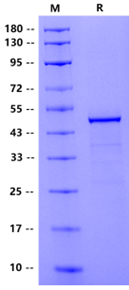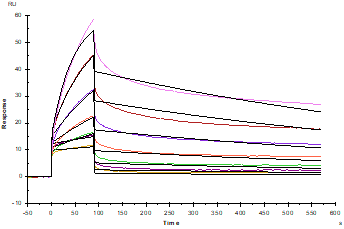Met1-Asp213, with N-terminal GST tag MSPILGYWKIKGLVQPTRLLLEYLEEKYEEHLYERDEGDKWRNKKFELGLEFPNLPYYIDGDVKLTQSMAIIRYIADKHNMLGGCPKERAEISMLEGAVLDIRYGVSRIAYSKDFETLKVDFLSKLPEMLKMFEDRLCHKTYLNGDHVTHPDFMLYDALDVVLYMDPMCLDAFPKLVCFKKRIEAIPQIDKYLKSSKYIAWPLQGWQATFGGGDHPPKMPRRAENWDEAEVGAEEAGVEEYGPEEDGGEESGAEESGPEESGPEELGAEEEMEAGRPRPVLRSVNSREPSQVIFCNRSPRVVLPVWLNFDGEPQPYPTLPPGTGRRIHSYRGHLWLFRDAGTHDGLLVNQTELFVPSLNVDGQPIFANITLPVYTLKERCLQVVRSLVKPENYRRLDIVRSLYEDLEDHPNVQKDLERLTQERIAHQRMGD
12 months from date of receipt, -20 to -70 °C as supplied; 6 months, -20 to -70 °C under sterile conditions after reconstitution; 1 week, 2 to 8 °C under sterile conditions after reconstitution; Please avoid repeated freeze-thaw cycles.
1、Pause A. et al. (1997) The von Hippel-Lindau tumor-suppressor gene product forms a stable complex with human CUL-2, a member of the Cdc53 family of proteins. Proc Natl Acad Sci U S A. 94(6):2156-2161.
Von Hippel-Lindau disease tumor suppressor (VHL) is a component of a ubiquitination complex, and involved in the ubiquitination and degradation of hypoxia-inducible-factor (HIF). Von Hippel-Lindau (VHL) disease, an autosomal dominant disease that can predispose individuals to multiple neoplasms, is characterized by heterozygous germline mutation in VHL gene on chromosome 3p. Germline pathogenic variants in the VHL gene predispose individuals to specific types of benign tumors, malignant tumors, and cysts in many organ systems. Mutation or transcriptional silencing of the VHL gene and subsequent loss of the remaining VHL allele are associated with sporadic, clear cell renal carcinoma, CNS hemangioblastomas, and other VHL-associated tumors, which make it a bona fide tumor-suppressor gene.


CM5 Chip captured HIF, Human, can bind VHL GST Tag, Human (Cat. No. UA070012) with an affinity constant of 0.23μM as determined in SPR assay.